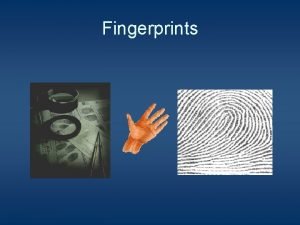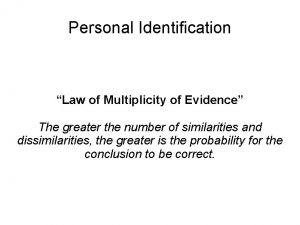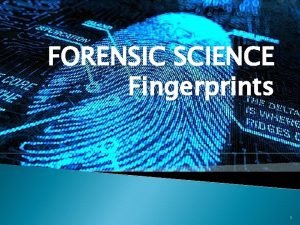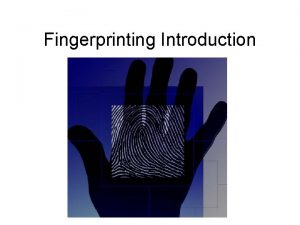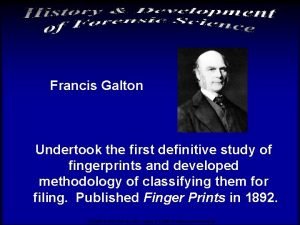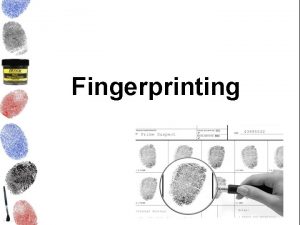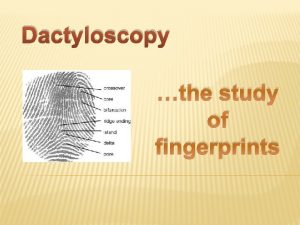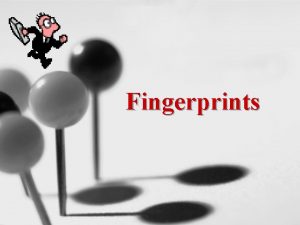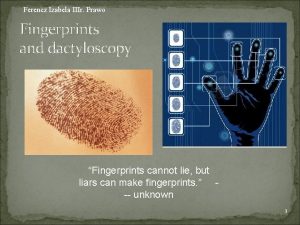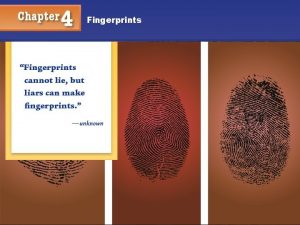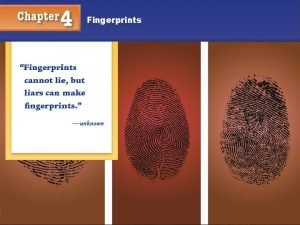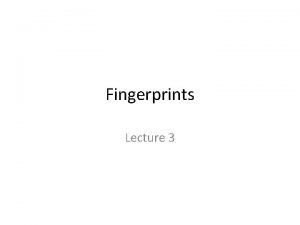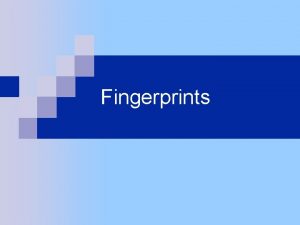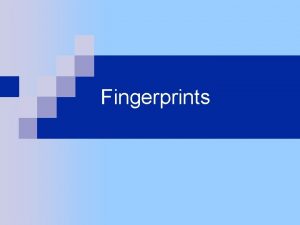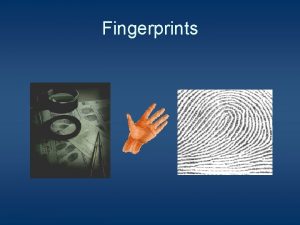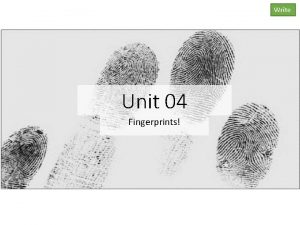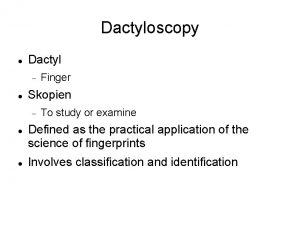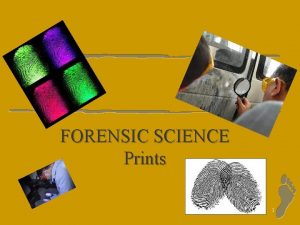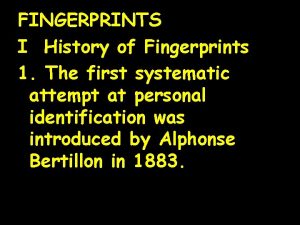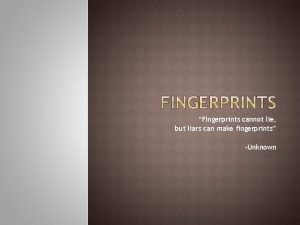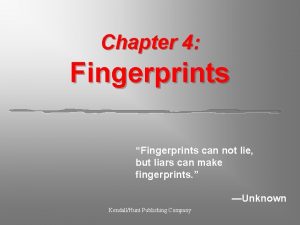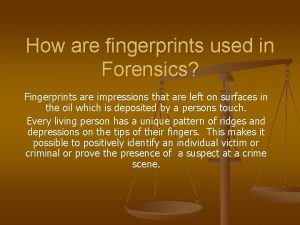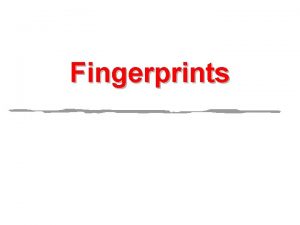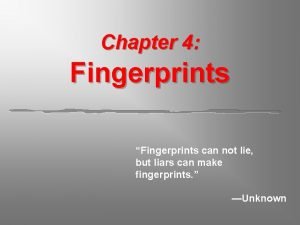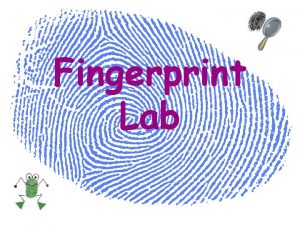Fingerprints The Study of Fingerprints Dactyloscopy What was



















































- Slides: 51

Fingerprints

The Study of Fingerprints: Dactyloscopy

What was used before f’prints? • Alphonse Bertillion (1883) – – French policeman Detailed description of the suspect Anthropometry 11 measurements • • • Height Expanse of his arms Circumference of his head (using calipers) Length of right ear Length of left foot Length of selected fingers Size and shape of nose Tilt of forehead Scars and blemishes – The possibility that 2 people would have the same measurements was 1 in 4 million • Ex: Will West (1903 – Leavenworth prison)


History • Bertillion system (Bertillonage) was used for 20 years (used to successfully ID 800 criminals) • William Herschel – India – Required that native sign for contracts using an imprint of their right hand • Henry Fauld – Scottish physician – Published in 1880 – skin ridge patterns could be important for the ID of criminals • Francis Galton – – 1892 published “Finger Prints” Discussed the anatomy of prints Recommended 3 categories • Loops, arches, whorls • No 2 fingerprints are alike

History • Creation of Classification systems – Needed a way of filing 1000’s of prints in a logical/searchable sequence • 1891 – Dr. Juan Vucetich (Argentinean police officer) – Devised a system that is still used by most Spanish speaking countries • 1897 – Sir Edward Richard Henry System – Adopted by Scotland Yard and most English speaking countries • In the US – 1901 – Officially adopted for applicants for the

History • In the US (cont. ) • 1924 – fingerprint records were combined to form the identification records of the newly formed FBI – Largest collection of fingerprints in the world • 1999 – US v. Byron C. Mitchell – Eastern PA – Defendant claimed that fingerprints could not be unique under the Daubert ruling – Judge came back with a verdict which stated • Human friction ridges are unique and permanent • Human friction ridge skin arrangements are unique and permanent

History • Daubert – Whether the scientific technique or theory can be (and has been) tested – Whether the technique or theory has been subject to peer review and publication – The techniques potential rate of error – Existence and maintenance of standards controlling the techniques operation – Whether the scientific theory or method has attracted widespread acceptance within a relevant scientific community

Fundamental Principles of Fingerprints § A fingerprint is an individual characteristic. § A fingerprint will remain unchanged during an individual’s lifetime. § Fingerprints have general characteristic ridge patterns that permit them to be systematically classified.

Stick to the Fundamentals • Three (3) Principles of Fingerprints • 1 st – A fingerprint is an individual characteristic; – no two fingers have yet been found to possess identical ridge characteristics – Individuality is determined by the number, ID and relative location of its ridge characteristics (minutiae) • There as many as 150 individual characteristics on the average fingerprint

Stick to the Fundamentals • Three (3) Principles of Fingerprints (cont. ) • Unfortunately - most prints only come in partials • 1973 – International Association of Identification – Concluded, “no valid basis exists for requiring a predetermined minimum number of friction ridge characters which must be present in 2 impressions in order to establish positive identification”

Ridge Characteristics Minutiae—characteristics of ridge patterns § § § § § Ridge ending Short ridge Dot or fragment Bifurcation Double bifurcation Trifurcation Bridge Island Enclosure Spur

Fingerprint Minutiae



Three Principles (cont. ) • 2 nd – A fingerprint will remain unchanged during an individual’s lifetime – Epidermis and Dermis – Fingerprints are a reproduction of skin ridges (used for friction/firmer grasps) – Dermal papillae – boundary between the dermis/epidermis • Determine the form and pattern of the ridges on the surface of the skin • Develop in the fetus


Three Principles (cont. ) • Each skin ridge has a single row of pores – openings for ducts leading form the sweat glands (perspiration) • Oils come for other parts of the body (no oil glands on hand/feet) – Both the sweat and oil can lead to… • Latent fingerprints – – Prints that are invisible to the naked eye • Impossible to change one's fingerprints – Ex: John Dillinger


Epidermal Ridges of Thick Skin

Three Principles (cont. ) • 3 rd – Fingerprints have general ridge patterns that permit them to be systematically classified • 3 classes – 1. loops (60 -65%) – ridge lines that enter from one side of the pattern and curve around to exit from the same side of the pattern • • • Ulnar – opens toward the little finger Radial – opens toward the thumb Type lines – two diverging lines that surround the loop • Delta – all loops must have one – The ridge point at or nearest the type line divergence – located at or directly in front of the point of divergence



Loop § A loop must have one or more ridges entering and exiting from the same side. Loops must have one delta. § Types § Radial—opens toward the thumb § Ulnar—opens toward the “pinky” (little finger) § Which type of loop is this, if it is on the right hand? Left hand?

Three Classes (cont. ) 2. whorls (30 -35%) – ridge patterns that are generally rounded or circular in shape…must have: – type lines and at least 2 deltas – At least one ridge that makes a complete circuit – Spiral, oval or any variant of a circle – 4 types: • plain whorl – If you can draw an imaginary line between the 2 deltas contained within these 2 patterns…and have the line touch any one of the spiral edges • pocket loop – If no such edge is touched the pattern is a central


Whorl

Whorl § A plain or central pocket whorl has at least one ridge that makes a complete circuit. A double loop is made of two loops. An accidental is a pattern not covered by other categories. Whorls have at least two deltas and a core. § Types § § § Plain Central Pocket Double Loop

Three Principles (cont. ) • Whorls (cont. ) – Double loop – 2 loops combined into one fingerprint – Accidental – • contains 2 or more patterns (not including the plain arch) • Pattern not covered by other categories


Three Classes (cont. ) • Arch (5%) – ridge lines that enter the print from one side and flow out the other side – Do not have type lines, deltas or cores – Least common – Plain arch – simplest of all • See definition above • Form a wavelike pattern – Tented arch • Instead of rising smoothly at the center there's a sharp spike or the ridges meet at an angle that is less than 90 degrees


Arch An arch has friction ridges that enter on one side of the finger and cross to the other side while rising upward in the middle. They do NOT have type lines, deltas, or cores. Types § Plain § Tented

Classification of Prints • Original Henry system • FBI System – Primary Classification • All the fingerprint cards in the world can be divided into 1, 024 groups • Pair up fingers

Classification of Prints (cont. ) • FBI System (cont. ) R. Index R. Ring L. Thumb R. Middle R. Little L. Middle L. Index L. Little L. Ring – Based on the presence/absence of a whorl pattern and then assigned a specific value • first pair - 16 • Second pair – 8 • Third pair – 4 • Fourth pair – 2 • Last/fifth pair – 1 (one) – Finger with an arch or loop pattern is assigned a zero (0)

Classification of Prints (cont. ) • FBI System (cont. ) R. Index R. Ring L. Thumb R. Middle R. Little L. Middle L. Index L. Little L. Ring – After values are taken for all 10 fingers…. they are totaled and 1 (one) is added to the numerator and the denominator – The resulting fraction is the primary classification – 25% of the population falls into the 1/1 category (all their fingers have loops or arches)

AFIS • Automated Fingerprint Identification Systems – A computer scans and digitally encodes fingerprints so they can be subject to high speed computer processing – determines the relative position and orientation of the minutiae – “Uses automatic scanning devices that convert the image of a fingerprints into digital minutiae that contain data showing ridges at their point of termination (? ) and the branching of ridges into 2 ridges (? )” – Makes no final decisions…that is left up

Kinds of Crime Scene Prints • Visible prints – – made by fingers touching a surface after ridges have been in contact with a colored materials (blood, paint, etc. ) • Plastic Prints – – ridge impressions left on a soft material (putty, wax, soap or dust) • Latent/invisible prints – – caused by the transfer of perspiration/oils on finger ridges to the surface of an object

Methods of Detection • Method of choice depends on the type of print • Hard/non-absorbent surfaces require different methods than soft/porous materials – Powders and Super Glue ® vs. chemical treatments • Most difficult aspect of fingerprint examination?

Methods (cont. ) • Visualization – RUVIS (Reflected Ultraviolet Imaging System) • Locates prints on most nonabsorbent surfaces without chemical or powders • UV light strikes the fingerprints, is reflected back to the viewer, then converted into visible light by an image intensifier


Visualization (cont. ) • Fingerprint powders – Applied to nonabsorbent surfaces with a camel hair or fiberglass brush • Adheres to oils/perspiration – Gray and black powders are adequate for most latent print work – Magnetic sensitive powder • Useful for leather and rough plastics – Fluorescent powders

Visualization (cont. ) • Iodine fuming (hardly used anymore) – Heat iodine crystals vapor without passing thru a liquid phase (? ) – How does it work? • Put suspect material in a cabinet with the heated iodine crystals • Vapors fill the chamber and combine with constituents of the latent print to make it visible • Reason? – No one knows for sure – fatty oils or residual water left on a print from perspiration • Problems – Not permanent -- fades once fuming is stopped • Therefore? – Must be photographed immediately – Or fixed with a 1% starch-water solution that is sprayed on » The print will then turn blue and last weeks-months

Visualization (cont. ) • Ninhydrin (another chemical) – Method of choice for most examiners • Extremely sensitive and easy to apply/use – Forms a purple-blue color with amino acids present in perspiration – Commonly sprayed on to porous surfaces – Prints begin to appear in an hour or 2 – Development can be hastened if the treated specimen is heated in an oven or hotplate at 80 -100 o. C – Has been used on papers as old as 15 years

Visualization (cont. ) • Physical Developer (yet another chemical) – Silver nitrate-based liquid reagent – Useful for turning up prints on porous surfaces that had been wet – Problem? • PD washes away any trace of protein that may be on/a part of the print/surface

Visualization (cont. ) • Super Glue ® Fuming – 1982 – Good for detection on nonporous surfaces such as metal, electrical tape, leather and plastic bags – Fumes can be created when the glue is placed on cotton treated with Na. OH (as well as heating the glue) – Put in an enclosed chamber for approx. 6 hours and the fumes from the glue will adhere to the latent print • Gives the print a white-appearance – Now have hand held wands that do the same thing…can direct the fumes to particular places (ex: car, etc. )

Visualization (cont. ) • Fluorescence – Def: when a substance absorbs light and reemits the light in wavelengths longer than the illumination source – Laser light • Perspiration contains a variety of components that fluoresce when exposed to lasers • Drawback? – Only small amounts of perspiration components are present in the fingerprint • The examiner wears safety goggles containing optical filters – The goggles will absorb some of the light, but let the wavelengths at which prints fluoresce pass thru

Visualization (cont. ) • Fluorescence and lasers (cont. ) – Treat fingerprints with chemicals that bring about fluorescence when exposed to lasers – Apply: • zinc chloride after ninhydrin treatment • dye rhodamine 6 G after Super Glue fuming

Visualization (cont. ) • Alternate Light Source – Because of chemically induced fluorescence, lasers no longer needed – High intensity lights are sufficient • Quartz halogen, xenon arc or indium can be focused in a suspect areas thru a fiber optic cable • Can be passed thru a number of filters – more flexibility as to the wavelength of light to be aimed at the print – Cheaper and more portable

Visualization (cont. ) • Common fingerprint agents do not interfere with DNA testing methods • Recommended that in cases involving items with material adhering to surfaces that will require further lab exams, fingerprint processing should not be performed at the crime scene

Preservation of Developed Prints • For future comparison – Take a picture…it’ll last longer • If the object on which the print is located is small enough to move/transport…take it wichya – Cover it in cellophane • If the print is a part of an object is too large to move, it can be lifted – Preserve the print with powder – Apply broad adhesive tape onto the print (evenly) – Place the tape/print on a properly labeled card that shows contrast – Also able to be used: adhesive-backed clear plastic sheet that is attached to a colored cardboard backing
 Similarities of dactyloscopy dactylography and dactylomancy
Similarities of dactyloscopy dactylography and dactylomancy State the 2 law of multiplicity of evidence
State the 2 law of multiplicity of evidence Dactyloscopy has been a forensic practice for 3000 years.
Dactyloscopy has been a forensic practice for 3000 years. 3 basic principles of fingerprints
3 basic principles of fingerprints Who undertook the first definitive study of fingerprints
Who undertook the first definitive study of fingerprints 8 fingerprint patterns
8 fingerprint patterns Các châu lục và đại dương trên thế giới
Các châu lục và đại dương trên thế giới Từ ngữ thể hiện lòng nhân hậu
Từ ngữ thể hiện lòng nhân hậu Hổ sinh sản vào mùa nào
Hổ sinh sản vào mùa nào Diễn thế sinh thái là
Diễn thế sinh thái là Thế nào là hệ số cao nhất
Thế nào là hệ số cao nhất Vẽ hình chiếu vuông góc của vật thể sau
Vẽ hình chiếu vuông góc của vật thể sau Ng-html
Ng-html 101012 bằng
101012 bằng Lời thề hippocrates
Lời thề hippocrates Tư thế worms-breton
Tư thế worms-breton đại từ thay thế
đại từ thay thế Quá trình desamine hóa có thể tạo ra
Quá trình desamine hóa có thể tạo ra Công thức tính độ biến thiên đông lượng
Công thức tính độ biến thiên đông lượng Sự nuôi và dạy con của hổ
Sự nuôi và dạy con của hổ Thế nào là mạng điện lắp đặt kiểu nổi
Thế nào là mạng điện lắp đặt kiểu nổi Dạng đột biến một nhiễm là
Dạng đột biến một nhiễm là Bổ thể
Bổ thể Vẽ hình chiếu đứng bằng cạnh của vật thể
Vẽ hình chiếu đứng bằng cạnh của vật thể Nguyên nhân của sự mỏi cơ sinh 8
Nguyên nhân của sự mỏi cơ sinh 8 độ dài liên kết
độ dài liên kết Thiếu nhi thế giới liên hoan
Thiếu nhi thế giới liên hoan Hát lên người ơi
Hát lên người ơi điện thế nghỉ
điện thế nghỉ Một số thể thơ truyền thống
Một số thể thơ truyền thống Trời xanh đây là của chúng ta thể thơ
Trời xanh đây là của chúng ta thể thơ Các số nguyên tố
Các số nguyên tố Tỉ lệ cơ thể trẻ em
Tỉ lệ cơ thể trẻ em Fecboak
Fecboak đặc điểm cơ thể của người tối cổ
đặc điểm cơ thể của người tối cổ Các châu lục và đại dương trên thế giới
Các châu lục và đại dương trên thế giới Sơ đồ cơ thể người
Sơ đồ cơ thể người ưu thế lai là gì
ưu thế lai là gì Các môn thể thao bắt đầu bằng từ đua
Các môn thể thao bắt đầu bằng từ đua Tư thế ngồi viết
Tư thế ngồi viết Cái miệng xinh xinh thế chỉ nói điều hay thôi
Cái miệng xinh xinh thế chỉ nói điều hay thôi Hát kết hợp bộ gõ cơ thể
Hát kết hợp bộ gõ cơ thể Mật thư anh em như thể tay chân
Mật thư anh em như thể tay chân Tư thế ngồi viết
Tư thế ngồi viết Thế nào là giọng cùng tên
Thế nào là giọng cùng tên Gấu đi như thế nào
Gấu đi như thế nào Thẻ vin
Thẻ vin Thơ thất ngôn tứ tuyệt đường luật
Thơ thất ngôn tứ tuyệt đường luật Time study objectives
Time study objectives What is work study in management
What is work study in management Time and motion study example ppt
Time and motion study example ppt Marty lobdel
Marty lobdel
